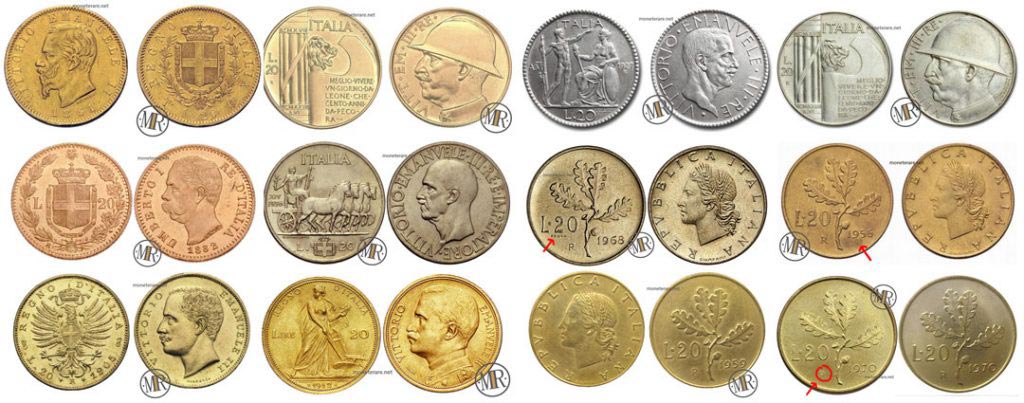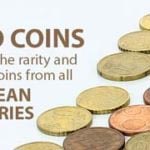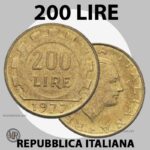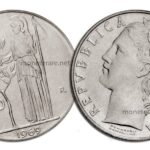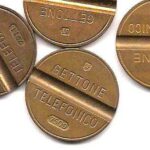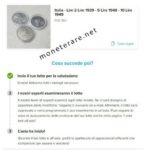In this pages we will deal with the Italian Euro Coins and as usual we will see not only the specifications of the different Euro coins from Italy, but also their rarity and their value.
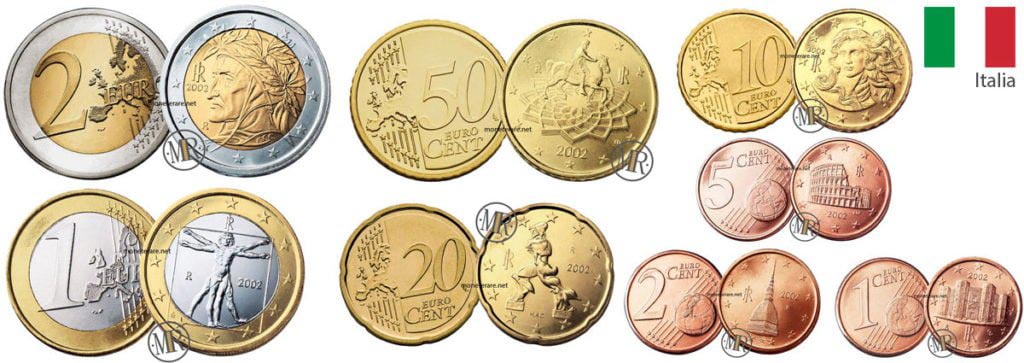
Introduction to Italian Coins
The history of Italian numismatics can be divided basically into 3 specific periods.
First Period
The first is the period between 1861 and 1946. In fact, 1861 is the year in which the famous Unity of Italy dates back to, with which an attempt was made to give a first national currency to Italy itself.
At that time in the Kingdom of Sardinia was already in use the “Lira” which was then used for other regions now unified under a single flag. It is important to underline that, for the realization and the production of the coins, different mints located in the main Italian cities were used.
The last mint to operate was in fact the Mint of Milan, which ceased its production in 1892 when it was decided to centralize the production of coins and entrust this activity to a single State Mint located in the capital.
Second Period
The second era of Italian numismatics dates back to the period between 1946 and 2001. In 1946, in fact, we witnessed the introduction of the Lira in the Italian Republic.
Third Period
Finally, the third period is that of the introduction of the Euro in 2002. In this regard, it must be said that Italy was one of the very first countries to introduce the Euro, modifying its monetary system immediately, while naturally allowing the parallel use of Lire and Euro for a limited period of time after January 1, 2002, the official date of the introduction of the Unitary Currency.
What we are interested in analyzing during this article are the different Italian Euro coins. We will evaluate their specifications, materials, weight and details.
It is important to underline that, with the exception of the 1 Euro coin, all the subjects represented on the Italian coins were chosen by the population through a television broadcast on 8 February 1998.
The subject of the 1 Euro coin was chosen by the then Minister for the Economy, Carlo Azeglio Ciampi.
In addition, each coin was made by a different artist.
Let’s start!
1 Cent Italian Euro Coins

Let’s start, of course, from the smallest denomination, that is 1 cent Italian Euro Coin. In particular, this coin was made by Eugenio Driutti as you can see through the initials.
The obvese represents the Castel del Monte di Andria in Puglia, commissioned by Frederick II of Swabia in the 13th century. Below you can see the inscription “RI” which indicates precisely “Italian Republic” while above naturally the thousandth of minting
As mentioned, there are also the initials of the author Eugenio Driutti (ED) on the right, while the whole is surrounded by 12 five-pointed stars representing the European Union.
On the reverse side is represented the classic symbol of the 1 cent present on the coins of all the countries of the European Union with the wording “1 Euro Cent” and the representation of Europe.
But let us now turn to the technical specifications.
Specifications of 1 cent Italian Euro Coins
Materials: The material used for this coin is copper-plated steel. Specifically, steel is present for 94.35% and copper for 5.65%.
Thickness: The thickness is not very high, equal to 1.67 mm.
Weight: The weight is also very low, 2.30 g
Diameter: The diameter is 16.25 mm
Side dish: The contour is completely smooth without the presence of any detail
Engraver: Eugenio Driutti
1 cent Italian Euro Coins Value and circulation
Of the Italian euro cent there is also a famous and precious minting error, of which you can read here: rare 1 cent Italian coin.
2 Cent Italian Euro Coins

Let us now move on to the next coin, the 2 euro cents. The coin in question was made by a woman, Luciana De Simoni.
In the obverse the “Mole Antonelliana of Turin” is represented in all its splendour. This is accompanied on the right by the thousandth of minting at the top and immediately below the mint sign or the letter “R”.
On the left of the Mole there is the symbol of the Italian Republic “RI” while at the bottom (under the Mole) the initials of the author “LDS”. All this is naturally surrounded by the 12 five-pointed stars representing the European Union.
As far as the reverse is concerned, it is identical to the other 2 euro cent coins present in the other European countries with the representation of Europe.
But let’s move on to the technical specifications.
Specifications of 2 cent Italian Euro Coins
Materials: Like the 1 Euro cent coin, the 2 cent coin is also made of copper-plated steel. In particular, steel is present for 94.35% while copper for 5.65%.
Thickness: The thickness is identical to the previous one, 1.67 mm
Weight: The weight is slightly higher at 3.06 g
Diameter: The diameter is 18.75 mm
Side dish: The contour is realized with horizontal thread in incuso
Engraver: Luciana De Simoni.
2 cent Italian Italian Euro Coins Value and circulation
5 Cent Italian Euro Coins
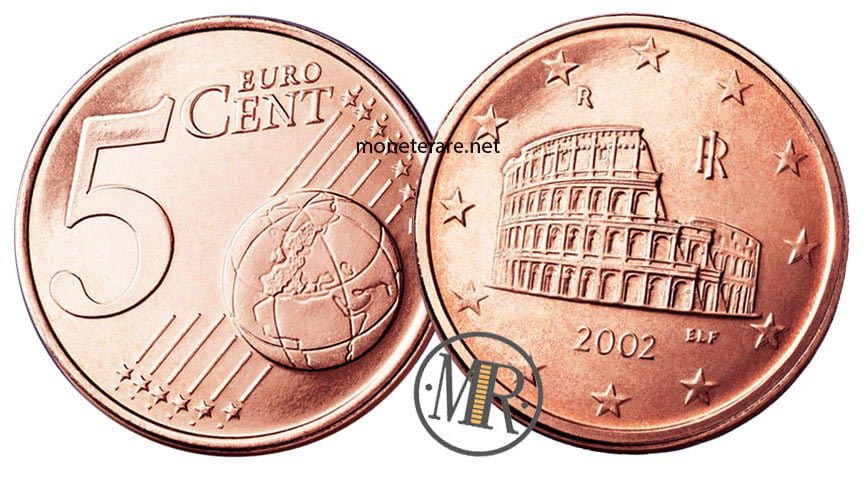
Let’s talk about the 5 cents Italian coin. This was made by Ettore Lorenzo Frapiccini and has slightly different characteristics than the first two coins seen up to this point.
At the obverse is represented the Colosseum, or Flavian Amphitheatre, that the emperor Vespasian began to build around 75 AD and that was inaugurated by the Emperor Titus in 80 AD.
In the top left is the letter “R” symbol of the State Mint, while on the right is the symbol “RI” representing the Italian Republic.
At the bottom of the center instead there is the thousandth of minting accompanied by the initials of the author “ELF”.
On the reverse side, the coin depicts Europe in the world like all other 5-cent European coins.
Let’s see the technical specifications.
Specifications of 5 cent Italian Euro Coins
- Materials: Also in this case the material used is steel plated with copper in which steel is present for 94.35% while copper for 5.65%.
- Thickness: The thickness is the same as the two previous coins or 1.67 mm
- Weight: Weight increases slightly to 3.92 g
- Diameter: The diameter also increases significantly. Specifically 21.25 mm
- Side dish: The contour returns to being completely smooth
- Engraver: Ettore Lorenzo Frapiccini
5 cent Italian Italian Euro Coins Value and circulation
10 Cent Italian Euro Coins
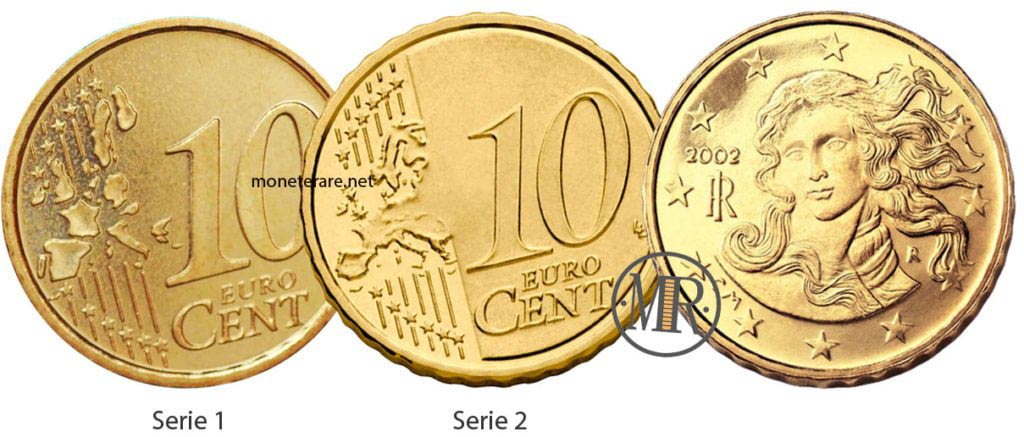
Here we are with the 10 cents Italian euro coins. Specifically, this was made by Claudia Momoni.
At the Straight end, the coin shows a detail of the work “The Birth of Venus” by Sandro Botticelli and kept in Florence in the Uffizi Gallery. The detail of the work of art is accompanied on the left by the monogram of the Italian Republic “RI” and immediately above the thousandth of minting.
Between the neck and the hair of Venus there is the mint symbol “R” while between the stars number 7 and number 8 of the 12 that make up the starry circle there are the initials of the author “CM”.
As far as the Reverse is concerned, there are two series. The first series dates back to the period between 2001 and 2007 and the second from 2008 onwards.
Between the two versions, the distinction between the number 10 and the representation of Europe changes.
Let’s see together the technical specifications
Specifications of 10 cent Italian Euro Coins
- Materials: The material changes completely compared to previous coins. In this case it is Nordic Gold characterized by 89% copper, 5% aluminum, 5% zinc and 1% tin.
- Thickness: The thickness increases slightly compared to the others reaching 1.93 mm
- Weight: Even the weight increases further by touching 4.10 g
- Diameter: the diameter on the contrary decreases slightly compared to the previous coin. Specifically 19.75 mm
- Side dish: The contour is grooved with thick knurling
- Engraver: Claudia Momoni
10 cent Italian Italian Euro Coins Value and circulation
20 Cent Italian Euro Coins
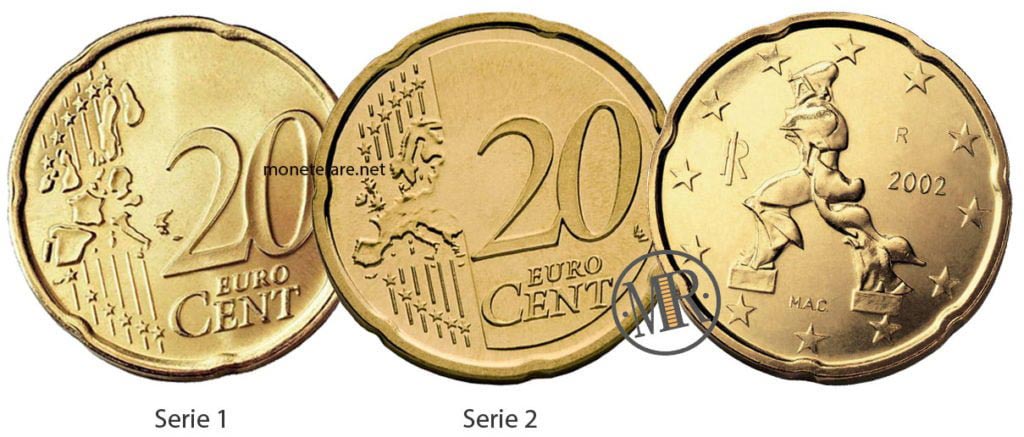
Let’s move on to the 20 euro cent coin made by Maria Angela Cassol.
In particular on the obverse this coin shows a work of art. It is the work “Unique Forms of Continuity in Space” created in 1913 by the Futurist sculptor Umberto Boccioni (1882 – 1916).
On the left there is the symbol of the Italian Republic “RI” while on the right there is the symbol of the State Mint “R” and on the bottom the thousandth of minting.
Immediately below the sculpture are engraved the initials of the author “M.A.C.”.
As far as the reverse is concerned, it is identical to all the other 20 cent coins, although there are two series, one dating back to the years 2001 to 2007 and the other from 2008 onwards.
However, let’s move on to the technical specifications.
Specifications of 20 cent Italian Euro Coins
- Materials: The 20-cent coin is also made of Nordic Gold (89% copper, 5% zinc, 5% aluminium, 1% tin).
- Thickness: The thickness is significantly higher than the others equal to 2.14 mm
- Weight: The weight in the same way makes a major leap up to 5.74 g
- Diameter: The diameter is 22.25 mm
- Outline: Wide knurling
- Engraver: Maria Angela Cassol
20 cent Italian Italian Euro Coins Value and circulation
50 Cent Italian Euro Coins
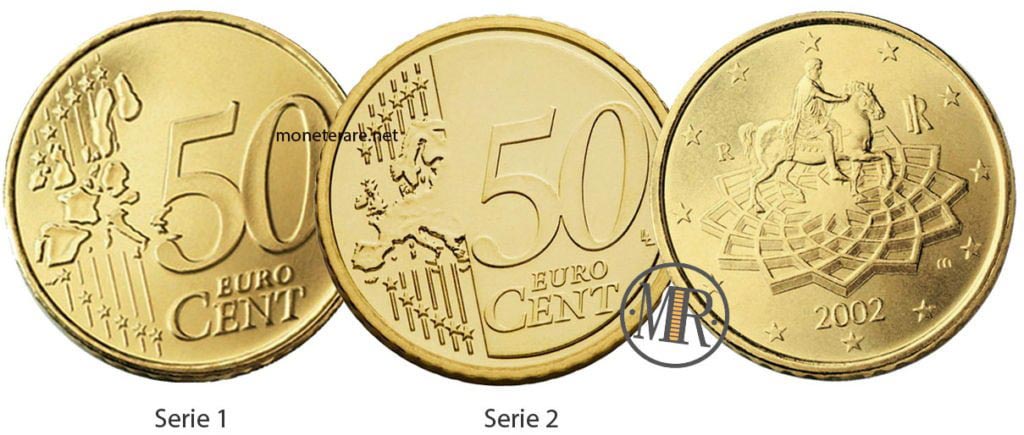
The 50 cent Italian euro coins have some very interesting characteristics (especially in the obverse). This was made specifically by Roberto Mauri.
To be more specific, the Obverse represents the equestrian sculpture of Marcus Aurelius combined with Michelangelo’s flooring in the Piazza del Campidoglio in Rome. On the right of the monument there is the symbol of the Italian Republic “RI” while on the left there is the symbol of the State Mint “R”.
In the lower part is placed the thousandth of minting while at the bottom right the initial of the surname of the author, then the letter “M”.
As far as the Verso is concerned, it is identical to the other 50-cent coins with the representation of Europe. Again, there are two series, one from 2001 to 2007 and the other from 2008 onwards.
Let’s move on to the technical specifications.
Specifications of 50 cent Italian Euro Coins
- Materials: The material used is Nordic Gold (copper 89% – aluminium 5% – zinc 5% – tin 1%)
- Thickness: The thickness increases slightly compared to the previous coin. We speak of 2.38 mm
- Weight: Weight also increases considerably to 7.80 g
- Diameter: The diameter is 24.25 mm
- Outline: The contour is grooved with thick knurling
- Engraver: Roberto Mauri
50 cent Italian Italian Euro Coins Value and circulation
1 Euro Italian Coin
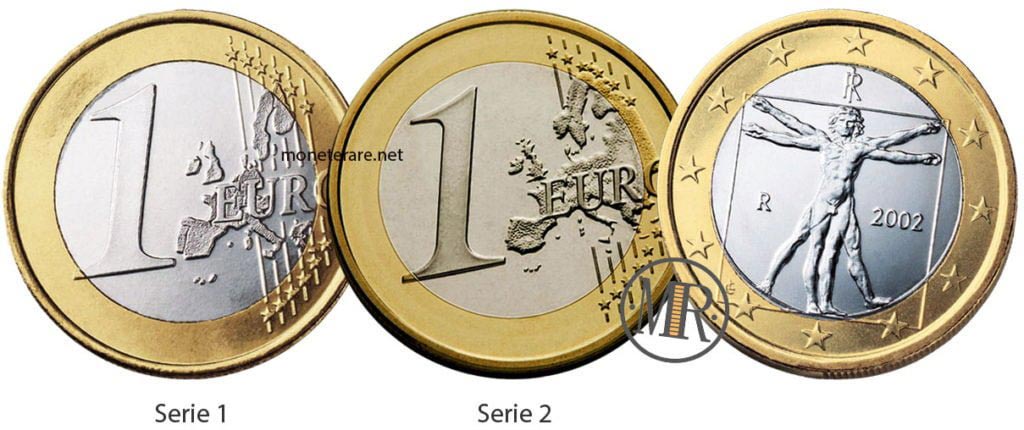
We have arrived at the 1 Euro Italian coin. This was made by Laura Cretara and the subject, as mentioned in the opening of the article, is the only one chosen by Carlo Azeglio Ciampi.
The obverse of the 1 euro Italian coin shows Leonardo da Vinci’s Vitruvian Man. This is nothing more than a representation of the proportional measures of the human body.
The symbol of the Italian Republic “RI” is placed just above the head of the man.
On the left is represented the symbol of the Mint “R” and on the right of the representation the thousandth of mintage. It is important to note that the 1 euro coin has two sections. On the inner one there is the Vitruvian Man while on the outer one there are represented the 12 5-pointed stars representing the European Union among which (precisely on star number 7) there are the initials of the author “LC”.
The Reverse of the coin is practically identical to the other coins of 1 Euro and also in this case there are two editions. The first one runs from 2001 to 2007 and the second one from 2008 onwards.
But let’s move on to the technical specifications.
Specifications of the Italian 1 Euro Coin
- Materials: The 1 euro coin has two sections made of different materials. The outer part is an alloy of nickel-brass (copper 75% – zinc 20% – nickel 5%), the inner part is instead an alloy of copper-nickel (copper 75% – nickel 25%).
- Thickness: The thickness is slightly lower than the previous one, 2.33 mm
- Weight: Same for weight 7.50 g
- Diameter: The diameter is 23.25 mm
- Outline: Discontinuously grooved
- Engraver: Laura Cretara
Italian 1 Euro Coin Value and circulation
Below are the quotations, the print runs and the values of the 1 euro Italian coin. Note the 1 euro coin italy 2016, 2017 and 2019 which has an interesting value. The 1 euro coins of year 2002 and 2008 are quoted as their face value.
2 Euro Italian Coin
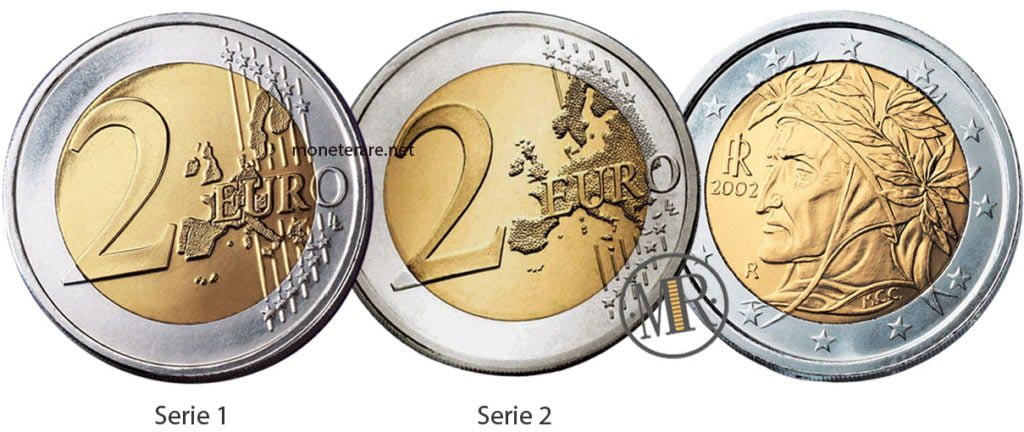
Finally, the last denomination is the 2 euro coin. In particular, this was made by Maria Carmela Colaneri.
On the obverse side, the coin shows the bust of Dante Alighieri taken from the “Parnassus of Raphael Sanzio”, located in the “Stanza della Signatura” of the Vatican Museums.
To the left of the bust are placed at the top of the symbol of the Italian Republic “RI” and immediately below the thousandth of minting. Always on the left, but slightly lower down near Dante’s chin, is the mint symbol “R”.
On the bottom right instead are indicated the initials of the author then “M.C.C.”. On the outer edge, of course, the 12 five-pointed stars representing the European Union.
As far as the reverse is concerned, this is the same as that of the other European 2 Euro coins.
Also in this case we are talking about a double version of which one dates back to the years between 2001 and 2007 and the second one dates back to after 2008.
But let’s see the technical specifications:
Specifications of the Italian 2 Euro Coin
- Materials: Also in this case the material is different between the outside and the inside. The outside is copper-nickel (copper 75% – nickel 25%), the inside is nickel-brass (copper 75% – nickel 20% – zinc 20%).
- Thickness: The thickness is equal to 2.20 mm
- Weight: The weight is the highest or 8.50 g
- Diameter: The diameter is 25.75 mm
- Outline: The contour is the most particular of all made up of six five-pointed stars and six alternating 2 numbers.
- Engraver: Maria Carmela Colaneri.
Italian 2 Euro Coin Value and circulation
Below is the value of the Italian 2-euro coins. The Italian 2 euro of 2012 have a value of “only” 2 euro. Please note well the value of the 2 euro Italian rare of 2018 and 2019 which is very high.
Do you want to learn more about Euro Coins?
- Two pages you can’t miss: 2 Euro Commemorative Coins and Rare Euro Coins
- The precious Vatican euro coins can be seen here and also the San Marino euro coins
- Here you can see the Malta euro coins and here the Cyprus euro coins.
- Euro coins from Germany can be found here and Euro coins from Estonia and Latvia Euro Coins here.
- Euro coins from France can be found here, as well as Euro coins from Austria.
- Also of great interest are the euro coins from Greece and the euro coins of Luxembourg.
- Here you will find Lithuania Euro coins and Andorra Euro coins
- We also talked about Slovenian Euro coins and Slovakia Euro coins.
- Check also Spanish Euro Coins here and Euro Coins of Portugal here.
- The Netherlands euro coins can be found here and the Ireland euro coins here.
- All precious Monaco Euro coins are here and Belgium Euro coins here


